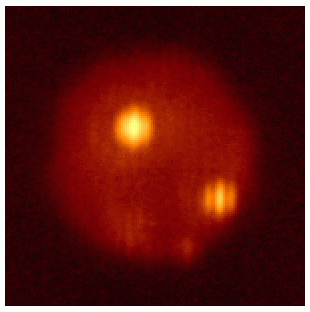Lava Waves Sweep Largest Volcanic Crater On Io
Io, one of Jupiter’s four largest moons, was first detected by Galileo Galilei in 1610, and astronomers discovered in the 1970 that its brightness was not constant. But it was only in 1979 as the Voyager 1 and 2 spacecraft flew by the gas giant and its moons that the change it brightness was attributed to volcanic activity on the Io’s surface.
Due to a recent, rare orbital alignment between Io and Europa — another of Jupiter’s four largest moons, together called the Galilean satellites — astronomers could observe the largest lava lake on Io with unprecedented detail. Io, the innermost of the Galilean satellites, is the most volcanically active body in the entire solar system, and its largest volcanic crater is called Loki Patera, after the Norse god.
Read: Saturn’s Moon Enceladus Has Heat Source Under Icy South Pole Exterior
When Europa passed in front of Io on March 8, 2015, it blocked the light from Io. Being covered in water ice, Europa also reflects very little sunlight in infrared wavelengths, allowing astronomers to study the heat emanating from Io. And the infrared data from the volcanic moon showed surface temperature steadily increasing from one end to the other, which suggested the movement of two lava waves moving from the west to the east at the speed of about one kilometer (0.62 miles) a day, according to a study to be published Thursday in the journal Nature.

This global view of Jupiter's moon, Io, was obtained during the tenth orbit of Jupiter by NASA's Galileo spacecraft at a range of more than 500,000 kilometers (310,000 miles), Sept. 19, 1997 . Photo: NASA/JPL/University of Arizona
The theory of lava waves in Loki Patera — about 200 kilometers (127 miles) across, with a surface area of 21,500 square kilometers, larger than Lake Ontario — is a popular one. The brightening of Loki Patera is seen to occur every 400 to 600 days, and the other theory to explain the phenomenon is about periodic eruptions that spread lava flows to large areas.
“If Loki Patera is a sea of lava, it encompasses an area more than a million times that of a typical lava lake on Earth. In this scenario, portions of cool crust sink, exposing the incandescent magma underneath and causing a brightening in the infrared,” Katherine de Kleer, a University of California, Berkeley, graduate student and the study’s lead author, said in a statement Wednesday.
In simpler words, the magma on the surface of a lava lake is cooler than the boiling inferno below. As the cooler crust thickens, its density gradually becomes greater than the magma it is floating on, and it sinks, pulling more crust with it. This movement creates a wave that propagates across the surface of the lava lake.

Loki Patera is the bright hot spot in the upper part of the disk, which is Io photographed in infrared. Photo: Large Binocular Telescope Observatory
The infrared images used for the study were captured by the Large Binocular Telescope Observatory in Arizona. Its twin 8.4-meter (27.6-foot) mirrors are linked together to allow interferometry which removes atmospheric blurring.
In the 10 seconds it took for Europa to completely cover Loki Patera, as seen from Earth, “there was so much infrared light available that we could slice the observations into one-eighth-second intervals during which the edge of Europa advanced only a few kilometers across Io's surface," co-author Michael Skrutskie, of the University of Virginia, who led the development of the infrared camera used for this study, said in the statement.
Related Articles


